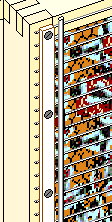The original ones used by Steve and John were of shallow dimensions, but the version described on this page is a British Standard brood frame that has been developed for use in a breeding project conducted by the Leicestershire and Rutland Beekeepers Association carried out at the Brooksby Bee Yard. It has two independent halves and providing the comb has no holes in it, the drones are effectively in four groups.
The inset shows the position of the dowels that locate the outer frames, further location is provided by the wide lower bars as they match up with the thinner 'normal' frame bottom bars.

The second variant is very similar, but is dimensioned in a way to suit the British Commercial hive.
This page amplifies information that can be found in John Atkinson's book 'Background to Bee Breeding', I have also discussed this and other aspects of Drone raising with John himself.
The Drone excluder Grid (DRONEX)is hard to come by and I have had to organise a specially produced batch, particularly for this project.
As a result of the manufacture of this batch, the opportunity was taken to ensure that the drone grid itself could be made to suit... National (& Smith) Brood, B. S. Commercial 16" x 10" and Langstroth Deep frames.
The shallow versions of these frames can either be made at shallow size or cut down from full grids. The grid has 2 mm wire on a 7.2 mm pitch giving a window space of 5.2 mm. The wire is hard drawn steel and has a copper coating (the same as 'lamp shade' frame wire).

The grid can be applied to the face of the frames using small staples. The ends of the 2 mm wires can be controlled by putting a bead of 'No Nails' glue along the edge of the sidebars, the excess being wiped off after the stapling. An alternative method of fixing can be achieved by screwing on thin capping strips to trap the wire ends. The material can be 2 or 3 mm 'birch' plywood that can be obtained from aero modeling shops or another material that I personally find quite useful for many purposes is the fibreglass substrate that is used for making printed circuits, this is available in thicknesses of 1.6 mm or 2.3 mm and 1.6 mm is plenty strong enough for this purpose.
Detailed drawings of parts to make the B.S. Standard version of the frame are provided, along with a chart giving alternative dimensions for making B.S. Commercial and Langstroth versions.
Dave Cushman.
Page created pre-2011
Page updated 07/12/2022